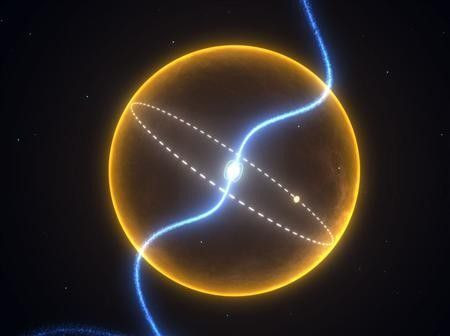How a Once-Massive Star Evolved into a Diamond Planet

Astronomers have discovered the densest extrasolar planet, apparently made of diamond, in our Milky Way galaxy, lying 4,000 light years away in the constellation of Serpens.
A team of astronomers from Australia, Germany, Italy, the UK and the U.S. discovered the exotic diamond planet during their search for a pulsar, using the Parkes 64-meter radio telescope in western New South Wales, Australia.
Astronomers first detected an unusual star called a pulsar, which is a small spinning star about 20 km in diameter - the size of a small city - that emits a beam of radio waves. As the star spins and the radio beam sweeps repeatedly over Earth, radio telescopes detect a regular pattern of radio pulses.
Irregular movements in the beams clued scientists in that there was a companion planet orbiting the pulsar, which then led them to the diamond planet. Astronomers said only two of the 1,800 known pulsars concealed planets and it's the first diamond planet ever seen.
Astronomers think that the diamond planet is all that remains of a once-massive star, most of whose matter was siphoned off towards the pulsar.
The planet, which is being dubbed as PSR J1719-1438, is denser than anything discovered so far, and is entirely made of carbon, according to the study led by Professor Matthew Bailes of Swinburne University of Technology in Australia.
A diamond forms when carbon is put under immense pressure. Since the molecules of the planet are tightly packed together, researchers believe that it must be crystalline in nature, making it effectively a giant celestial diamond.
The evolutionary history and amazing density of the planet all suggest it is comprised of carbon -- i.e., a massive diamond orbiting a neutron star every two hours in an orbit so tight it would fit inside our own Sun, said Bailes.
Researchers said the planet is also likely to have oxygen apart from carbon. Because of its high density, scientists think that lighter elements like hydrogen and helium are not present in the planet.
Astronomers say that the arrival times of the pulses were systematically modulated due to the gravitational pull of a small companion planet, orbiting the pulsar in a binary system.
The planet orbits the pulsar in just two hours and 10 minutes, and the distance between the two objects is 600,000 km - a little less than the radius of our Sun.
In addition, the companion must be small, less than 60,000 km (about five times the Earth's diameter). The planet is so close to the pulsar that, if it were any bigger, it would be ripped apart by the pulsar's gravity.
But despite its small size, the planet has slightly more mass than Jupiter which provides a clue to its origin.
Pulsar J1719-1438 is a very fast-spinning pulsar - what's called a millisecond pulsar. It rotates more than 10,000 times per minute, has a mass of about 1.4 times that of our sun but is only 20 km in diameter.
About 70 per cent of millisecond pulsars have companions of some kind. Astronomers think it is the companion that, in its star form, transforms an old, dead pulsar into a millisecond pulsar by transferring matter and spinning it up to a very high speed. The result is a fast-spinning millisecond pulsar with a shrunken companion - most often a so-called white dwarf.
We know of a few other systems, called ultra-compact low-mass X-ray binaries, that are likely to be evolving according to this scenario and may likely represent the progenitors of a pulsar like J1719-1438, said Andrea Possenti, director of the INAF-Osservatorio Astronomico di Cagliari in Italy.
But pulsar J1719-1438 and its companion are so close together that the companion can only be a very stripped-down white dwarf, one that has lost its outer layers and more than 99.9 per cent of its original mass.
This remnant is likely to be largely carbon and oxygen, because a star made of lighter elements like hydrogen and helium would be too big to fit the measured orbiting times, said Michael Keith, one of the research team members.
Astronomers say that the new diamond planet demonstrates that special circumstances can conspire during binary pulsar evolution that allows neutron star stellar companions to be transformed into exotic planets unlike those likely to be found anywhere else in the Universe.
The density means that this material is certain to be crystalline: that is, a large part of the star may be similar to a diamond, researchers say.
A video of Bailes explaining the discovery can be viewed below:
© Copyright IBTimes 2025. All rights reserved.





















